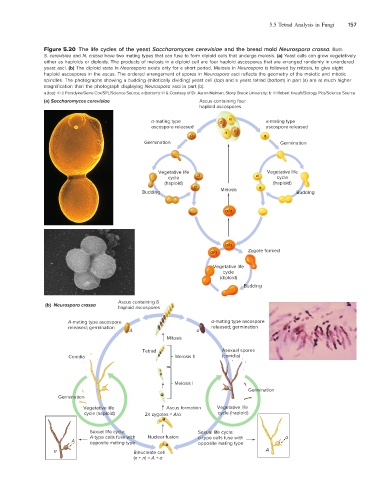Page 165 - Genetics_From_Genes_to_Genomes_6th_FULL_Part1
P. 165
5.5 Tetrad Analysis in Fungi 157
Figure 5.20 The life cycles of the yeast Saccharomyces cerevisiae and the bread mold Neurospora crassa. Both
S. cerevisiae and N. crassa have two mating types that can fuse to form diploid cells that undergo meiosis. (a) Yeast cells can grow vegetatively
either as haploids or diploids. The products of meiosis in a diploid cell are four haploid ascospores that are arranged randomly in unordered
yeast asci. (b) The diploid state in Neurospora exists only for a short period. Meiosis in Neurospora is followed by mitosis, to give eight
haploid ascospores in the ascus. The ordered arrangement of spores in Neurospora asci reflects the geometry of the meiotic and mitotic
spindles. The photographs showing a budding (mitotically dividing) yeast cell (top) and a yeast tetrad (bottom) in part (a) are at much higher
magnification than the photograph displaying Neurospora asci in part (b).
a (top): © J. Forsdyke/Gene Cox/SPL/Science Source; a (bottom): © & Courtesy of Dr. Aaron Neiman, Stony Brook University; b: © Robert Knauft/Biology Pics/Science Source
(a) Saccharomyces cerevisiae Ascus containing four
haploid ascospores
a-mating type a -mating type
ascospore released ascospore released
a
a
Germination Germination
Vegetative life Vegetative life
cycle a cycle
(haploid) (haploid)
a
Budding Meiosis Budding
a/
a/
a/ Zygote formed
Vegetative life
cycle
(diploid)
Budding
Ascus containing 8
(b) Neurospora crassa
haploid ascospores
A-mating type ascospore a-mating type ascospore
released; germination released; germination
A a
Mitosis
Tetrad Asexual spores
Conidia Meiosis II (conidia)
Meiosis I
Germination
Germination
Vegetative life Ascus formation Vegetative life
cycle (haploid) 2n zygotes = A/a cycle (haploid)
Sexual life cycle: Sexual life cycle:
A-type cells fuse with Nuclear fusion a-type cells fuse with a
A opposite mating type opposite mating type
a Binucleate cell A
(n + n) = A + a

